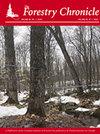按管理和非管理的北方硬木和混合木材的死亡模式划分树木死亡风险
IF 0.8
4区 农林科学
Q3 FORESTRY
引用次数: 10
摘要
我们使用了一个永久性样地网络来监测加拿大魁北克成熟的北方阔叶林和混交林的森林管理效果,以解决与树木死亡率相关的两个重要问题:(1)部分砍伐如何影响树木死亡率?(2)哪些变量最能解释树木在不同死亡模式下的死亡(直立死亡、连根拔起或茎断)?部分采伐后10年树木死亡率低于未采伐地块,但树木年死亡率相似(1.25%·年-1)。在树木水平上,风险产品分类显示了影响总死亡率的最有力证据,其次是物种、伐木伤害的存在和树木大小。年温度是解释树木死亡总风险变化的唯一气候变量,并且总是在解释三种死亡模式之间差异的前三个变量中。站立死亡的风险也随着年降水量的增加而增加。本文章由计算机程序翻译,如有差异,请以英文原文为准。
Partitioning risks of tree mortality by modes of death in managed and unmanaged northern hardwoods and mixedwoods
We used a permanent sample plot network established to monitor the effects of forest management practiced in mature northern hardwood and mixedwood stands in Quebec, Canada to address two important questions related to tree mortality: (1) How does partial cutting affect tree mortality? (2) Which variables best explain tree mortality by different modes of death (standing death, uprooting or stem breakage)? Decennial tree deaths were lower after partial cutting than in unharvested plots, but the annual proportion of tree death was similar (1.25%·year-1). At the tree level, a risk-product classification demonstrated the strongest evidence on influencing total mortality, followed by species, the presence of a logging injury, and tree size. Annual temperature was the only climatic variable explaining variations in total risk of tree mortality, and always among the first three variables explaining differences among the three modes of death. The risk of standing death also increased with increasing annual precip...
求助全文
通过发布文献求助,成功后即可免费获取论文全文。
去求助
来源期刊

Forestry Chronicle
农林科学-林学
CiteScore
1.20
自引率
0.00%
发文量
6
审稿时长
18-36 weeks
期刊介绍:
The Canadian Institute of Forestry has published The Forestry Chronicle, a professional and scientific forestry journal, since 1925. The Forestry Chronicle is published to provide information to forest practitioners about professional and scientific management of forests and their resources. The Forestry Chronicle provides forest practitioners in Canada and around the world with a means to communicate with their peers in the professional community.
 求助内容:
求助内容: 应助结果提醒方式:
应助结果提醒方式:


